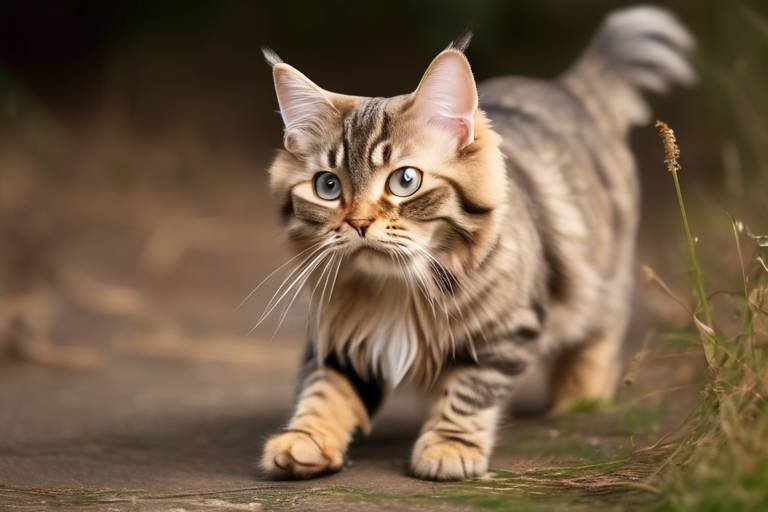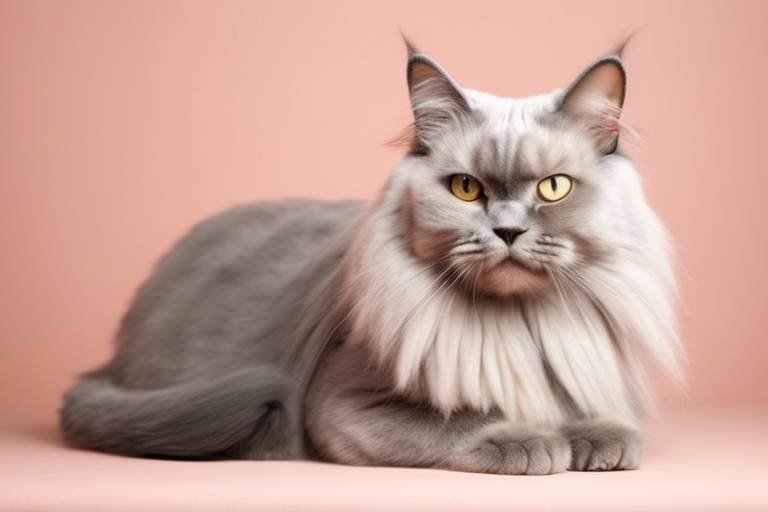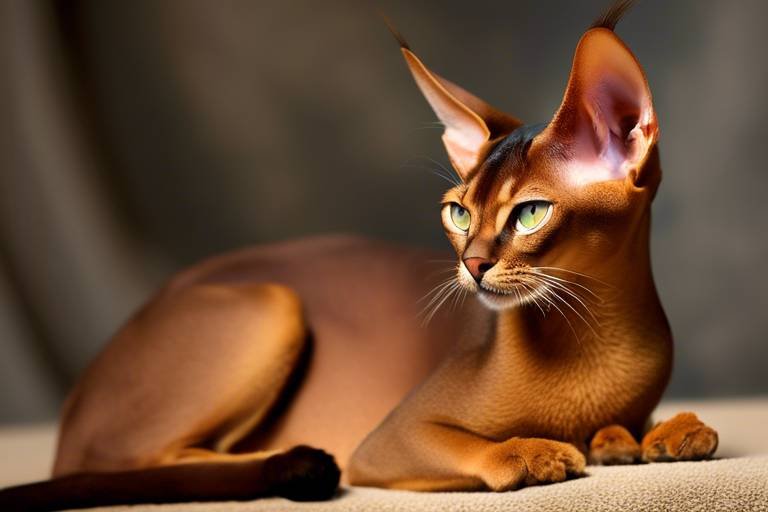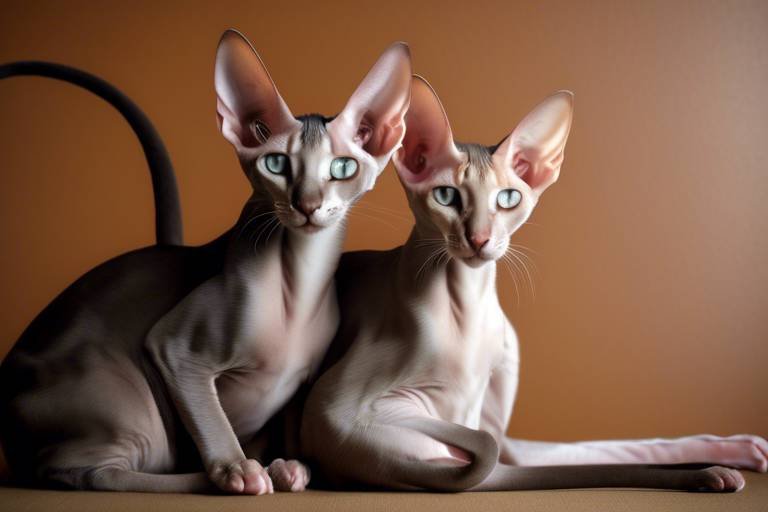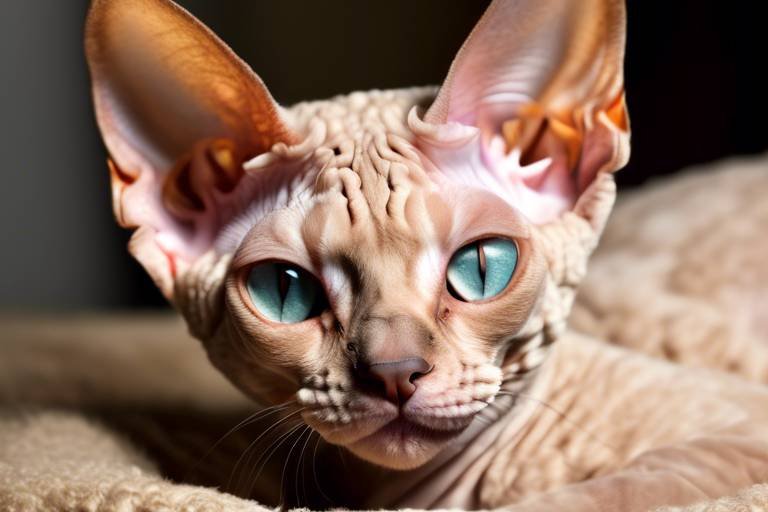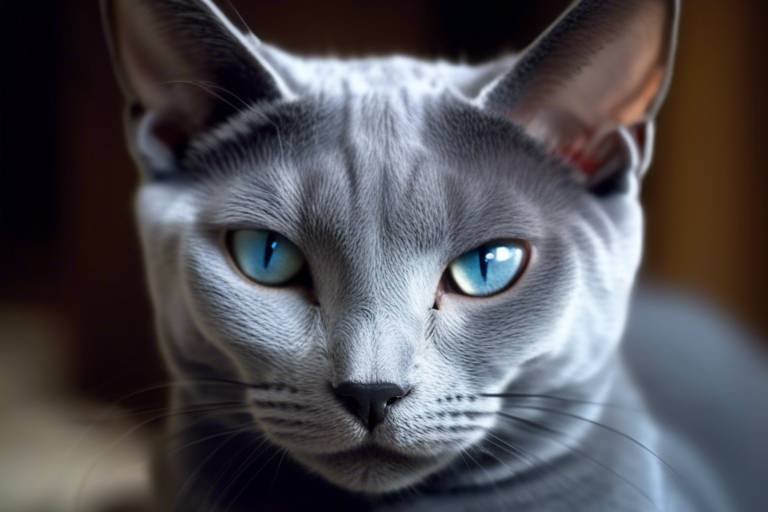Understanding the Differences Between Cat Breeds
Choosing a cat can feel like a daunting task, especially with the myriad of breeds available, each with its own unique quirks and charms. When you think about it, selecting a feline companion is a bit like finding your perfect partner; you want someone who complements your lifestyle and personality. Some breeds are known for their playful antics, while others are more laid-back and affectionate. This article dives deep into the fascinating world of cat breeds, illuminating their distinctive characteristics, temperaments, and care needs. By understanding these differences, potential cat owners can make informed decisions that lead to a harmonious relationship with their new furry friend.
Let's start by exploring the most popular cat breeds that have captured the hearts of cat lovers around the globe. From the fluffy Persian to the sleek Siamese, each breed brings something special to the table. But what makes these cats so appealing? It often boils down to their unique traits. For instance, Ragdolls are famous for their docile nature and love of cuddling, while Bengals are known for their energetic playfulness and striking appearance. When considering a cat, it’s essential to think about not just how they look, but also how they behave. After all, a cat's personality can significantly impact your home life.
Moreover, understanding the temperament of various breeds is crucial. Some cats are natural entertainers, ready to engage in a game of chase or fetch, while others prefer to lounge in a sunbeam, soaking up the warmth. This brings us to the concept of active versus calm breeds. If you’re someone who enjoys an interactive pet that will keep you on your toes, then an active breed might be your best bet. On the flip side, if you value tranquility and a low-maintenance companion, a calm breed could be just what you need. The right match can make all the difference in creating a loving and fulfilling pet-owner relationship.
For those who thrive on activity, certain breeds are known for their high energy levels. These cats often require more playtime and mental stimulation to keep them happy. Breeds like the Abyssinian and the Siamese are notorious for their playful antics and love of interactive toys. They need owners who can dedicate time to play and exercise, ensuring they don’t become bored or destructive. On the other hand, calm breeds such as the British Shorthair or the Scottish Fold are perfect for those who prefer a quieter home environment. These cats are typically more content to lounge around the house, making them ideal companions for individuals or families who value a more laid-back lifestyle.
In addition to temperament, it’s important to consider the health aspects of each breed. Some breeds may be predisposed to specific health issues, which can influence your decision. For example, Persian cats are known for their beautiful, long fur but can suffer from respiratory problems due to their flat faces. Understanding these genetic predispositions can help you prepare for potential medical needs, ensuring your feline friend enjoys a long, healthy life. Regular veterinary check-ups and preventive care are essential for all breeds, regardless of their specific health challenges.
In conclusion, understanding the differences between cat breeds is not just about picking a pretty face; it’s about finding a companion that fits your lifestyle and preferences. Whether you’re drawn to the playful nature of an active breed or the serene demeanor of a calm one, there’s a perfect cat out there for everyone. As you embark on this journey to find your feline friend, remember to consider their characteristics, temperament, and health needs. After all, a well-informed decision will lead to a happier, more fulfilling companionship.
- What are the most popular cat breeds? Some of the most popular breeds include the Persian, Maine Coon, Ragdoll, and Bengal.
- How do I choose the right cat breed for my home? Consider your lifestyle, activity level, and whether you prefer a playful or calm cat.
- Are certain cat breeds more prone to health issues? Yes, some breeds have specific genetic predispositions that can affect their health.
- What kind of care do active cats need? Active cats require plenty of playtime, mental stimulation, and regular exercise to stay happy.
- How often should I take my cat to the vet? Regular check-ups at least once a year are recommended for all cats.
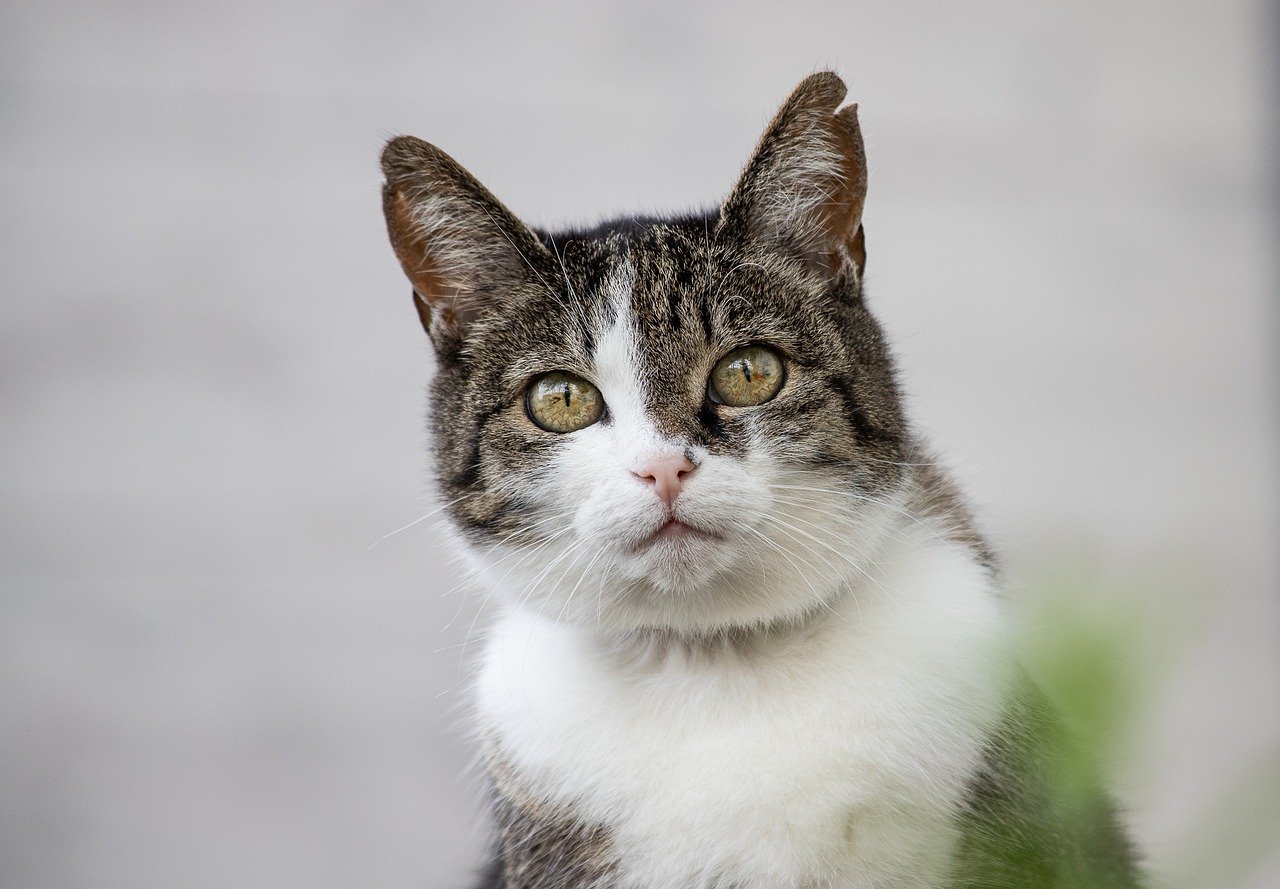
Popular Cat Breeds
This article explores the various cat breeds, highlighting their unique characteristics, temperaments, and care needs to help potential cat owners make informed decisions when choosing their feline companions.
When it comes to choosing a feline friend, the options can feel overwhelming! With so many cat breeds out there, how do you know which one is the perfect match for you? Let's dive into some of the most that have stolen the hearts of cat lovers around the globe.
Each breed brings its own unique blend of personality, appearance, and quirks. For instance, the Persian is known for its luxurious coat and calm demeanor, making it a favorite among those who prefer a more laid-back companion. On the other hand, the Bengal cat, with its striking spotted coat, is an energetic and playful breed that thrives on interaction and playtime.
Here’s a quick look at a few popular breeds and what makes them special:
| Breed | Characteristics | Temperament |
|---|---|---|
| Persian | Long, luxurious fur; flat face | Calm, affectionate |
| Bengal | Spotted coat; athletic build | Active, playful |
| Siamese | Short coat; striking blue eyes | Vocal, social |
| Maine Coon | Large size; tufted ears | Friendly, gentle |
Each of these breeds has its own unique set of traits that appeal to different lifestyles. For example, if you're someone who enjoys a quiet evening at home, the Persian might be your best bet. But if you love hosting friends and want a cat that will entertain, the Bengal could be your ideal match.
In addition to their physical attributes, it’s important to consider their care needs. Some breeds, like the Persian, require regular grooming due to their long fur, while others, like the American Shorthair, are relatively low-maintenance. Understanding these needs can help you provide the best environment for your new furry friend.
So, as you contemplate which breed to welcome into your home, think about your lifestyle and what you’re looking for in a companion. Whether you want a playful partner or a calm cuddle buddy, there’s a breed out there that’s just right for you!
Learn about the different temperaments associated with various cat breeds, from playful and energetic to calm and affectionate, and how these traits influence their suitability as pets.
Explore the characteristics of active cat breeds, which thrive on play and interaction, making them ideal for families and individuals seeking a lively companion.
Find out which specific breeds are known for their high energy levels and playful nature, ensuring they keep their owners entertained.
Understand the unique care requirements for active cat breeds, including exercise needs and mental stimulation to keep them happy and healthy.
Delve into the world of calm cat breeds, which are often more laid-back and suitable for quieter households or individuals seeking a more relaxed pet.
Examine the common health issues associated with different cat breeds, allowing prospective owners to prepare for potential medical needs and ensure a long, healthy life for their pets.
Learn about the genetic predispositions of certain breeds and how they can affect overall health, longevity, and care requirements.
Discover the importance of preventive care for all cat breeds, including regular check-ups and vaccinations to maintain optimal health.
Have questions about choosing the right cat breed? Here are some common inquiries:
- What is the best cat breed for families with children? Breeds like the Maine Coon and Ragdoll are often recommended due to their friendly and tolerant nature.
- How do I know if a cat is right for my lifestyle? Consider factors like activity level, grooming needs, and temperament to find a breed that fits your life.
- Are some breeds more prone to health issues? Yes, certain breeds have genetic predispositions that may lead to health problems, so it's essential to research before adopting.
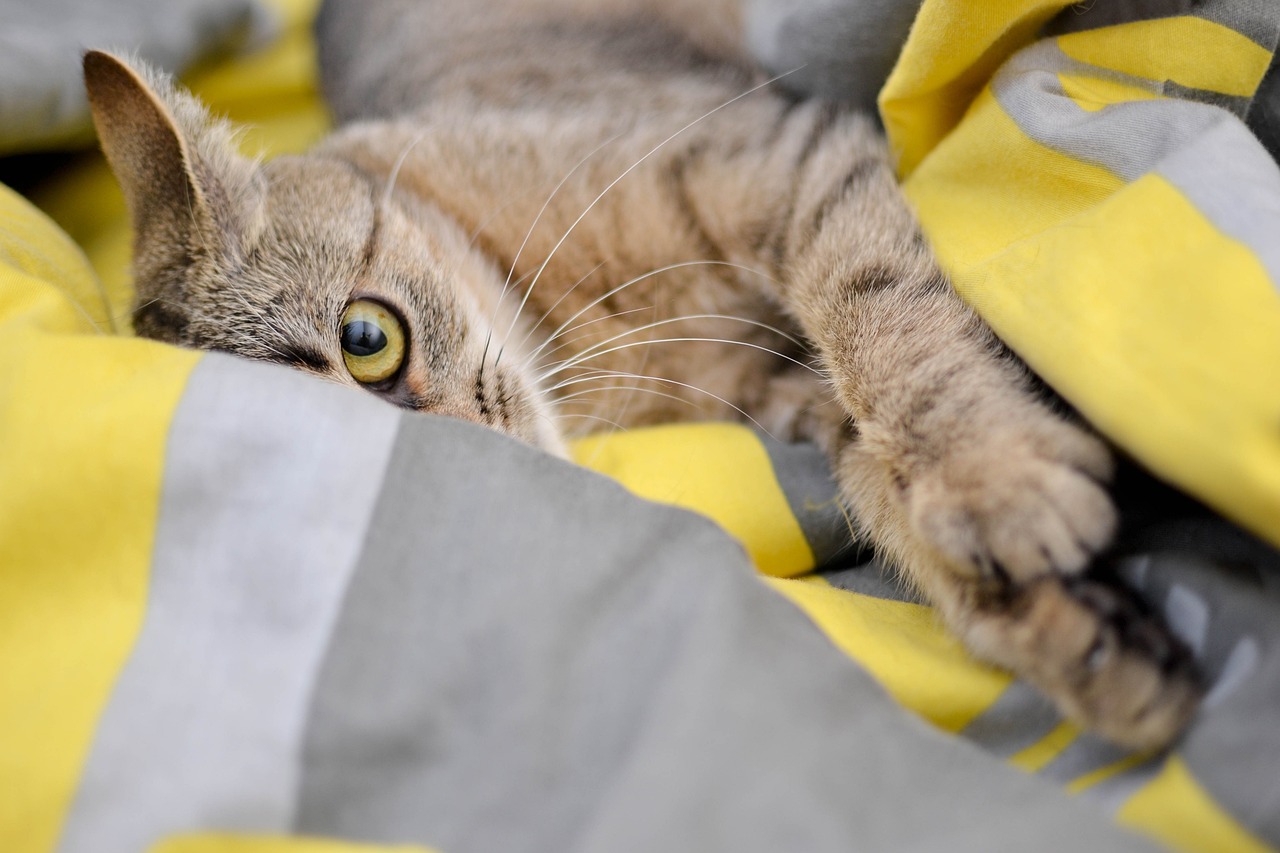
Breed Temperament
When it comes to welcoming a furry friend into your home, understanding the temperament of different cat breeds is crucial. Just like people, cats have their own unique personalities and quirks that can significantly influence how they fit into your lifestyle. Some breeds are known for their playful antics, while others might prefer a more laid-back approach to life. So, how do you choose the right breed for you? Let’s dive into the fascinating world of feline temperaments!
Many cat breeds exhibit distinct behavioral traits that can help potential owners make informed decisions. For instance, the Persian is often characterized by its calm and gentle demeanor, making it an ideal choice for those seeking a quiet companion. On the other hand, the Abysinian is known for its high energy and playful nature, perfect for families who enjoy interactive playtime. Understanding these differences can be the key to finding a cat that matches your lifestyle.
In general, cat temperaments can be categorized into a few main types:
- Active and Playful: Breeds like the Oriental Shorthair and Siamese thrive on interaction and play, often requiring more engagement from their owners.
- Calm and Affectionate: Breeds such as the Ragdoll and British Shorthair tend to be more relaxed, making them suitable for quieter households.
- Independent: Some breeds, like the Russian Blue, are known for their self-sufficiency, often enjoying their own company without constant attention.
Understanding these categories can help you determine which type of cat would best suit your home and lifestyle. For example, if you have children or other pets, an active breed might be the perfect fit, as they often enjoy the hustle and bustle of a lively household. Conversely, if you live alone or in a quieter environment, a calm breed could provide the companionship you seek without overwhelming your space.
It's also essential to consider how a cat's temperament can change with age. Kittens are typically more energetic and playful, but as they mature, many breeds tend to settle down. Knowing this can help you prepare for the long-term companionship of your cat. For instance, while a young Scottish Fold may be full of energy, you might find that they become more relaxed and cuddly as they grow older.
In conclusion, understanding the temperament of different cat breeds is vital for ensuring a harmonious relationship between you and your feline friend. By considering factors like energy levels, social needs, and adaptability, you can make a choice that not only suits your lifestyle but also provides a loving home for your new companion.
Here are some common questions potential cat owners often have regarding cat breed temperaments:
- Are all cats affectionate? - Not all breeds have the same level of affection. While some are naturally cuddly, others may be more independent.
- Do active cats require more care? - Yes, active breeds often need more playtime and mental stimulation to keep them happy and healthy.
- Can a calm cat be playful? - Absolutely! Even calm breeds can enjoy playtime, but they may prefer shorter, less intense sessions.
Active Breeds
When it comes to choosing a feline companion, active breeds are often at the top of many people's lists. These cats are not just pets; they are lively little dynamos that bring a burst of energy and joy into any household. Imagine coming home after a long day, and instead of a sleepy cat lounging around, you are greeted by an enthusiastic ball of fur ready to play! Active breeds are known for their playful nature, which can be incredibly rewarding for owners who enjoy interactive playtime and engaging activities.
But what exactly makes a cat "active"? Generally, these breeds have a higher energy level and require more stimulation than their calmer counterparts. They thrive on play, whether it’s chasing after a feather toy, climbing to new heights in a cat tree, or engaging in a good old-fashioned game of hide-and-seek. If you’re considering an active breed, be prepared to invest time into daily play sessions and mental challenges to keep your furry friend entertained. Think of it as a workout for both you and your cat!
Here are a few characteristics that define active cat breeds:
- Playfulness: These cats love to engage in games and activities that stimulate their hunting instincts.
- Curiosity: Active breeds are often more inquisitive, exploring their surroundings and investigating new sights and sounds.
- Social Interaction: They enjoy the company of their human companions and may even get along well with other pets.
Some popular active breeds include the Abyssinian, known for their playful antics and love for climbing; the Bengal, which resembles a wild cat and has an insatiable curiosity; and the Oriental Shorthair, who thrives on social interaction and playtime. Each of these breeds brings a unique flair to the household, making them a joy to have around.
However, owning an active cat also comes with its own set of responsibilities. These breeds need ample space to roam and explore, as well as plenty of toys to keep their minds sharp. It's essential to create an enriching environment that encourages physical activity and mental stimulation. Consider investing in climbing structures, puzzle toys, and interactive games that challenge their intelligence and agility.
In summary, active breeds are perfect for families or individuals who lead a dynamic lifestyle and are looking for a companion that matches their energy. Just remember, with great energy comes great responsibility! Ensuring that your active cat has a stimulating environment and plenty of playtime will lead to a happy, healthy, and well-adjusted feline friend.
Examples of Active Breeds
When it comes to active cat breeds, there are a few standouts that not only bring joy to their owners but also keep them on their toes! These cats are like the live wires of the feline world, bursting with energy and enthusiasm. If you're considering bringing one of these playful companions into your home, here are some notable examples that are sure to capture your heart:
- Abyssinian: Known for their stunning ticked coat and playful demeanor, Abyssinians are often described as the clowns of the cat kingdom. They love to climb, explore, and engage with their humans, making them a fantastic choice for families.
- Bengal: With their striking leopard-like appearance, Bengals are not just a pretty face; they are incredibly energetic and love to play fetch! Their intelligence and curiosity mean they thrive in environments where they can explore and interact.
- Siamese: These vocal and social cats are always up for a game. Siamese cats are known for their affectionate nature and love to be involved in whatever their owners are doing. If you want a cat that will keep you company while you work or relax, a Siamese might be the one for you.
- Oriental Shorthair: Similar to the Siamese in personality, Oriental Shorthairs are playful and intelligent. They enjoy interactive play and are known for their strong bonds with their owners. Their sleek appearance and variety of colors make them visually appealing as well.
- Russian Blue: While they may have a calm demeanor, Russian Blues can be quite playful and enjoy engaging in activities that stimulate their minds and bodies. They are also known for their loyalty and affectionate nature.
These breeds are not just about looks; they have personalities that can keep you entertained for hours. Imagine a Bengal cat chasing after a feather toy or an Abyssinian climbing up to the highest shelf in your home. It's like having a little acrobat performing just for you! However, with all this energy comes a responsibility. You need to ensure that these active cats have plenty of outlets for their energy. Regular playtime, interactive toys, and even cat trees can help keep them physically and mentally stimulated.
In summary, if you are looking for a feline friend that can match your energy and enthusiasm for life, consider one of these active cat breeds. They will not only provide companionship but also keep you entertained with their playful antics. Just remember that with great energy comes the need for great playtime!
Care for Active Cats
Caring for active cats is like nurturing a little whirlwind of energy and curiosity. These feline dynamos have a zest for life that requires owners to step up and meet their needs, ensuring they remain happy and healthy. First and foremost, it's essential to provide ample playtime. Active cats thrive on interaction, so investing in a variety of toys—like feather wands, laser pointers, and interactive puzzles—can keep them engaged. Think of it as providing a gym for your cat; the more activities available, the more they’ll enjoy their workout!
Moreover, creating an enriching environment is crucial. This means having climbing structures, scratching posts, and cozy hideaways that allow your cat to explore and express their natural behaviors. It’s like giving them their own jungle gym where they can climb, jump, and play to their heart's content. Don't forget about mental stimulation! Incorporating puzzle feeders can challenge their minds while rewarding them with treats, making mealtime an adventure rather than a chore.
Another important aspect of caring for active cats is ensuring they get sufficient exercise. Regular play sessions should be a part of your daily routine. Aim for at least 30 minutes of interactive play each day. You might find that your cat loves chasing after a ball or darting around after a toy mouse. The key is to keep it fun and varied to prevent boredom. Just like humans, cats can become less enthusiastic about exercise if it feels repetitive.
Additionally, it's vital to monitor their health closely. Active cats can sometimes be prone to injuries due to their high energy levels. Regular veterinary check-ups, vaccinations, and a balanced diet tailored to their activity level will help ensure they stay in top shape. If you notice any signs of lethargy or changes in behavior, don't hesitate to consult your vet. Remember, an ounce of prevention is worth a pound of cure!
In summary, caring for active cats involves a combination of play, mental challenges, and regular health monitoring. By providing a stimulating environment and ensuring they have plenty of exercise, you’ll not only keep them happy but also strengthen the bond you share. After all, a well-cared-for active cat is not just a pet; they’re a vibrant part of your family!
- What types of toys are best for active cats? Look for interactive toys like feather wands, laser pointers, and puzzle feeders that engage them physically and mentally.
- How much exercise does an active cat need? Aim for at least 30 minutes of interactive play each day to keep them stimulated and healthy.
- Are there specific health concerns for active breeds? Yes, active cats can be prone to injuries, so regular vet check-ups and monitoring their health is crucial.
- Can I train my active cat? Absolutely! Active cats often enjoy learning new tricks and can be trained using positive reinforcement techniques.
Calm Breeds
When you think of a calm cat, what comes to mind? Imagine a serene companion, lounging in a sunbeam, purring softly as you stroke their fur. are often the perfect fit for individuals or families looking for a more relaxed pet. These felines are typically less demanding than their more energetic counterparts, making them ideal for quieter households or those who appreciate a laid-back lifestyle. But what exactly defines a calm breed? It’s all about their temperament, which tends to be gentle, affectionate, and sometimes a bit shy.
Many calm breeds can be quite social and enjoy human interaction, but they won’t demand your attention every minute of the day. Instead, they prefer to cuddle up next to you or watch the world go by from a cozy perch. Breeds like the British Shorthair, Ragdoll, and Persian are known for their easygoing nature. These cats are often content to sit quietly while you read a book or binge-watch your favorite series. They embody the essence of tranquility, providing a soothing presence in your home.
However, it's important to remember that even calm breeds need their share of mental and physical stimulation. While they may not be as active as other breeds, they still enjoy playtime and interactive toys. Providing them with a few engaging activities can help keep their minds sharp and prevent boredom. For instance, consider investing in
- Feather wands
- Interactive puzzle toys
- Catnip mice
Moreover, the environment in which calm breeds thrive is crucial. They often prefer a peaceful setting where they can retreat to their favorite spots when they need a break from the hustle and bustle of home life. Creating a safe and cozy space with soft bedding and quiet corners will help them feel secure. Remember, a calm cat is a happy cat, and ensuring they have a serene environment is key to their well-being.
In conclusion, if you’re seeking a feline friend who embodies tranquility, calm breeds might just be your perfect match. They offer companionship and affection without the high energy demands of other breeds. By understanding their unique needs and characteristics, you can create a loving home for these gentle souls, ensuring they thrive and bring joy to your life.
Q: What are some examples of calm cat breeds?
A: Some popular calm cat breeds include the British Shorthair, Ragdoll, and Persian. These breeds are known for their gentle and affectionate nature.
Q: Do calm breeds require a lot of exercise?
A: While calm breeds are generally less active, they still need regular playtime to keep them mentally stimulated. Engaging toys and interactive play can help meet their exercise needs.
Q: How can I create a peaceful environment for my calm cat?
A: Providing cozy bedding, quiet corners, and a safe space where your cat can retreat will help create a tranquil atmosphere. Avoid loud noises and disturbances to keep your cat feeling secure.
Q: Are calm breeds good for families with children?
A: Yes, many calm breeds can be great companions for families. However, it’s essential to teach children how to interact gently and respectfully with cats to ensure a harmonious relationship.
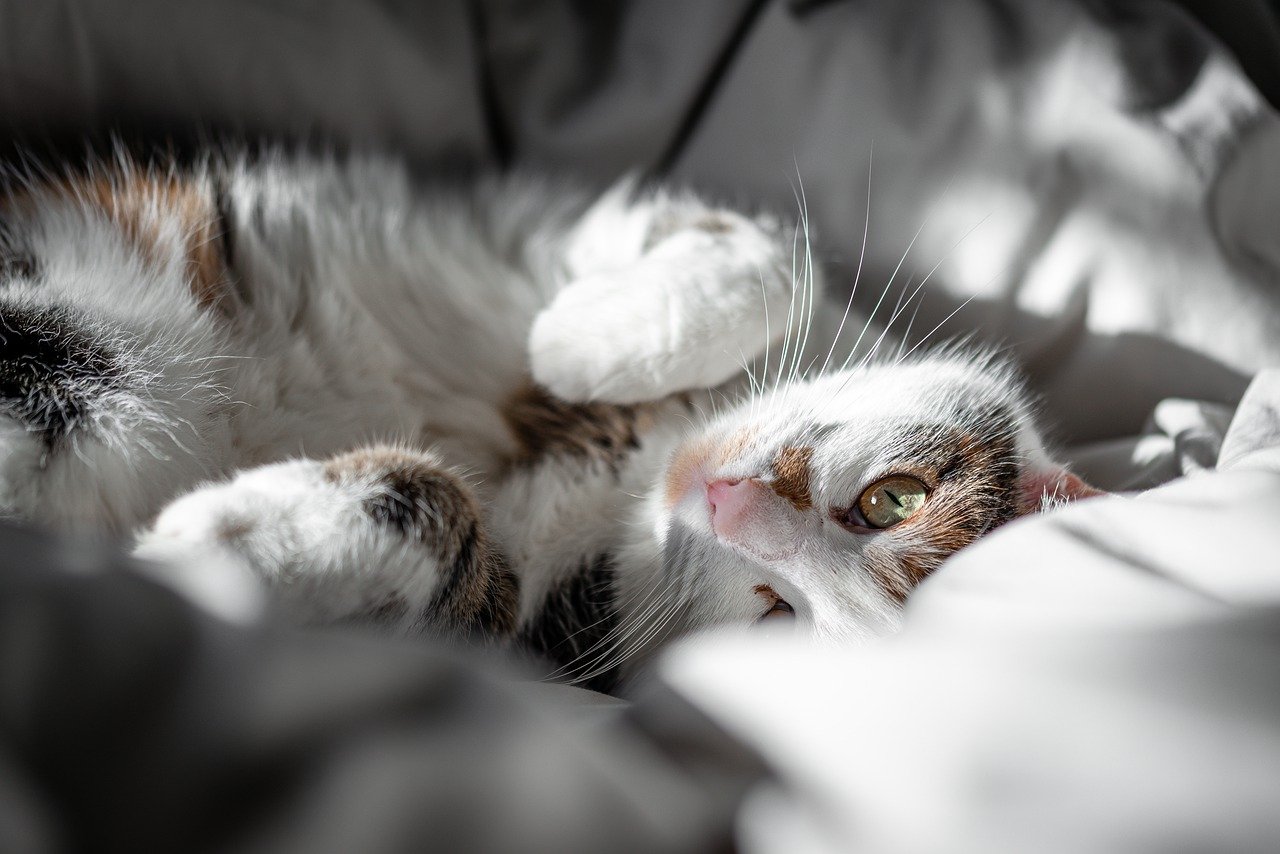
Health Considerations
When it comes to welcoming a cat into your home, understanding the associated with different breeds is crucial. Each breed comes with its own set of genetic predispositions that can affect their overall health, longevity, and care requirements. For instance, some breeds are more prone to certain conditions than others, and being informed can help you prepare for any potential medical needs your feline friend may have.
One of the most important aspects to consider is the genetic predisposition of certain breeds. For example, the Persian breed is known for its gorgeous long fur, but this also makes them susceptible to skin issues and respiratory problems due to their flat faces. On the other hand, Siamese cats are often more vocal and social but may be prone to certain types of cancers. Understanding these predispositions can help you make informed decisions about which breed might be the best fit for your lifestyle and environment.
In addition to breed-specific health issues, there are common health concerns that all cat owners should be aware of. Regular veterinary check-ups are essential, as they can catch potential health problems before they become serious. Vaccinations are another critical component of preventive care, protecting your cat from diseases such as feline leukemia and rabies. A well-planned schedule of vaccinations can significantly contribute to your cat's long-term health.
To give you a clearer picture of some common health issues associated with various cat breeds, consider the following table:
| Cat Breed | Common Health Issues |
|---|---|
| Persian | Respiratory issues, kidney disease |
| Siamese | Cancers, dental issues |
| Maine Coon | Hypertrophic cardiomyopathy (HCM) |
| Ragdoll | Heart disease, urinary tract issues |
Beyond genetics, preventive care is equally important for ensuring your cat lives a long and healthy life. Regular grooming, especially for long-haired breeds, can prevent matting and reduce the risk of skin infections. Additionally, providing a balanced diet tailored to your cat's age and activity level can prevent obesity, which is a growing concern among pet owners. Engaging your cat in regular play and exercise not only keeps them fit but also enhances their mental well-being, reducing the risk of behavioral issues.
In summary, being aware of the health considerations associated with different cat breeds can help you prepare for the joys and challenges of cat ownership. By understanding their unique health needs and committing to regular veterinary care, you can ensure that your feline companion enjoys a happy, healthy life by your side.
- What are the most common health issues in cats? Common health issues include obesity, dental problems, and various genetic conditions depending on the breed.
- How often should I take my cat to the vet? It's recommended to take your cat for a check-up at least once a year, or more frequently if they have specific health concerns.
- Do certain breeds require more care than others? Yes, some breeds, especially those with long hair or unique physical traits, may require more grooming and specialized care.
Genetic Predispositions
Understanding the of various cat breeds is crucial for anyone looking to adopt a feline companion. Just like humans, cats inherit certain traits from their parents that can affect their health, behavior, and overall well-being. This means that some breeds are more prone to specific health issues than others. For example, the Siamese breed is known for its striking appearance and vocal nature, but it also has a genetic predisposition to respiratory problems. Similarly, Maine Coons are prone to hypertrophic cardiomyopathy, a heart condition that can lead to serious health complications.
When considering a breed, it's essential to be aware of these inherited traits. Some breeds may have a genetic makeup that makes them more resilient, while others might require more frequent veterinary visits. For instance, the Persian cat, with its luxurious fur and calm demeanor, often faces challenges related to their flat faces, which can lead to breathing difficulties. On the other hand, active breeds like the Abyssinian tend to have fewer genetic health issues, making them a popular choice for those seeking a low-maintenance pet.
Here’s a quick overview of some common breeds and their genetic predispositions:
| Breed | Common Genetic Issues |
|---|---|
| Siamese | Respiratory issues, dental problems |
| Maine Coon | Hypertrophic cardiomyopathy |
| Persian | Brachycephalic airway syndrome |
| Abyssinian | Generally healthy, few genetic issues |
As a future cat owner, it’s vital to do your homework. Researching the specific breed you’re interested in can help you prepare for any potential health issues. Regular check-ups with a veterinarian are essential to catch any problems early on. Additionally, understanding these genetic predispositions can help you make informed decisions about diet, exercise, and lifestyle to ensure your furry friend lives a long, healthy life.
- What are the most common health issues in cats? Common health issues include dental disease, obesity, and kidney disease.
- How can I ensure my cat stays healthy? Regular vet check-ups, a balanced diet, and plenty of exercise are key.
- Are certain breeds more prone to specific diseases? Yes, many breeds have genetic predispositions to certain health conditions.
Preventive Care
When it comes to keeping your feline friend happy and healthy, is key. Just like humans, cats require regular check-ups and vaccinations to fend off potential health issues. Think of it as a shield that protects them from a variety of ailments, ensuring they live a long and fulfilling life. Imagine your cat as a warrior, and preventive care is their armor against the uncertainties of life. By taking proactive measures, you not only enhance your cat's quality of life but also save yourself from unexpected vet bills down the line.
Regular veterinary visits should be a cornerstone of your cat's healthcare routine. During these visits, your vet will perform a thorough examination, check for any signs of illness, and recommend appropriate vaccinations based on your cat's age, lifestyle, and health status. Vaccinations are crucial in protecting against diseases such as feline leukemia, rabies, and panleukopenia. Just like you wouldn’t skip your own vaccinations, your cat deserves the same attention to health!
In addition to vaccinations, includes routine dental check-ups, as dental health is often overlooked in cats. Dental disease can lead to serious health complications, so maintaining oral hygiene through regular cleanings and at-home dental care is essential. Think of it this way: a healthy mouth leads to a happy cat. You wouldn’t want your best friend to suffer from toothaches, would you?
Another important aspect of preventive care is parasite control. Fleas, ticks, and worms can wreak havoc on your cat's health, causing discomfort and even severe health issues. It’s vital to have a parasite prevention plan in place. Many vets recommend year-round treatments, and it’s always a good idea to discuss the best options for your specific situation. Just like a knight needs a trusty steed, your cat needs reliable protection against these pesky invaders!
To further enhance your cat's health, consider investing in a balanced diet and regular exercise. A well-nourished cat is less likely to develop obesity-related issues, which can lead to diabetes and joint problems. Incorporating playtime into your daily routine not only strengthens your bond but also keeps your cat physically and mentally stimulated. After all, a happy cat is a healthy cat!
Lastly, don’t underestimate the importance of mental well-being. Stress can manifest in cats just like it does in humans, leading to behavioral issues and health problems. Creating a safe, enriching environment filled with toys, scratching posts, and cozy resting spots can significantly reduce stress levels. Think of your home as a sanctuary for your cat, where they can relax and thrive.
- How often should I take my cat to the vet? It's recommended to take your cat for a check-up at least once a year, but older cats or those with health issues may need more frequent visits.
- What vaccinations do cats need? Common vaccinations include rabies, feline distemper, and feline leukemia. Your vet can provide a tailored vaccination schedule.
- How can I tell if my cat is stressed? Signs of stress in cats can include hiding, excessive grooming, changes in appetite, and aggression. If you notice these behaviors, consult your vet.
- What are the best ways to keep my cat active? Interactive toys, laser pointers, and regular play sessions can help keep your cat engaged and active.
Frequently Asked Questions
- What are the most popular cat breeds?
Some of the most popular cat breeds include the Persian, Maine Coon, Bengal, and Siamese. Each of these breeds has unique characteristics that make them beloved by cat owners around the world. For instance, Persians are known for their long, luxurious fur and calm demeanor, while Bengals are energetic and playful, capturing the hearts of those who love an active pet.
- How do I choose the right cat breed for my lifestyle?
Choosing the right cat breed depends on your lifestyle and preferences. If you’re looking for a playful companion, consider breeds like the Abyssinian or Oriental Shorthair, which are full of energy. On the other hand, if you prefer a more laid-back pet, breeds like the British Shorthair or Scottish Fold might be perfect for you. Think about your living situation, how much time you can dedicate to play, and whether you have children or other pets.
- What are the temperament differences between cat breeds?
Cat breeds can vary significantly in temperament. For example, Ragdolls are known for their gentle and affectionate nature, making them great lap cats, while Russian Blues are typically more reserved but very loyal. Understanding these differences can help you select a breed that aligns with your personality and household dynamics.
- What care do active cat breeds require?
Active cat breeds, like the Turkish Van and Savannah, require plenty of exercise and mental stimulation. Engaging them with toys, interactive play sessions, and climbing structures can keep them happy and healthy. It's essential to provide them with a stimulating environment to prevent boredom and destructive behavior.
- Are there specific health issues associated with certain cat breeds?
Yes, some cat breeds are predisposed to specific health issues. For example, Persians are prone to respiratory problems due to their flat faces, while Maine Coons may face heart issues like hypertrophic cardiomyopathy. It's crucial for prospective cat owners to research these potential health concerns and discuss them with a veterinarian.
- How can I ensure preventive care for my cat?
Preventive care is vital for all cat breeds. Regular veterinary check-ups, vaccinations, and dental care play a significant role in maintaining your cat's health. Additionally, keeping an eye on their diet and weight can prevent many common health issues. Establishing a routine can help ensure your feline friend stays in tip-top shape!





